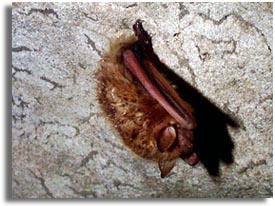 Bats are the only members of the mammal family that can fly. Like all
mammals they have fur and are warm blooded. They also give live birth and
produce milk for their babies. Bats are the only members of the mammal family that can fly. Like all
mammals they have fur and are warm blooded. They also give live birth and
produce milk for their babies.
Bats are in the scientific order Chiroptera (kie-rop-ter-a), which means
'hand-wing' and are known to live from 10 to 32 years.
Bats
are widely distributed throughout the US, we have a list of
bat species by state. Some bat species such as the Indiana bat are considered endangered. Primary reasons for
populations declines include - habitat loss, pesticides, predation, and roost
disturbance. |